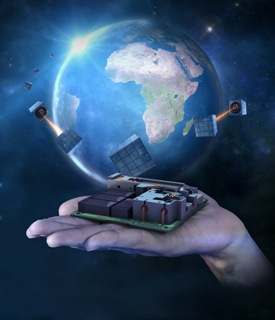Oct 14 2014
Two new projects have launched at the Centre for Quantum Technologies thanks to funding awards by Singapore's National Research Foundation (NRF). The projects on "Hybrid Quantum Technologies" and "Space Based Quantum Key Distribution" will apply the Centre's expertise to advanced challenges. They have received funding under NRF's Competitive Research Programme grant scheme totalling over $10 million.
 The SPEQS programme is developing technology for a global quantum communication network. Pictured in the foreground is the first generation Small Photon-Entangling Quantum System (SPEQS), a sandwich-sized device that can produce and characterise entangled photon pairs.
The SPEQS programme is developing technology for a global quantum communication network. Pictured in the foreground is the first generation Small Photon-Entangling Quantum System (SPEQS), a sandwich-sized device that can produce and characterise entangled photon pairs.
Space Based Quantum Key Distribution
Over five years from October 2014, Principal Investigator Alexander Ling will lead a team to demonstrate technology for a global quantum communication network.
The project will build on the team's experience developing a Small Photon-Entangling Quantum System (SPEQS) to produce and characterise entangled photons on a nanosatellite. CQT Principal Investigator Stephanie Wehner joins the new project to develop communication protocols for the challenging environment.
Why might we want a quantum network? One reason is secure communication. A quantum network can distribute encryption keys with security guarantees that cannot be achieved using any classical network.
Quantum key distribution (QKD) is most secure when it's done with pairs of photons that are 'entangled' with each other. Distribution of entangled photons from satellites is a promising way to achieve long-distance transmissions, given that entanglement is too delicate to survive long journeys down optical fibres.
"Thanks to the support of Singapore's National Research Foundation, we will be able to develop cost-effective satellites dedicated to quantum technology demonstrations in low earth orbit. We are excited about both the possibility of testing fundamental physics in space and the potential of our work to translate to real-word applications," says Alexander.
The team was awarded over $6 million by NRF to develop an ultra-bright, second-generation device, SPEQS-2, that can communicate to ground or satellite to satellite. They will also build the nanosatellite in which it will be launched. The fundamental physics of entanglement has not yet been tested in space. The satellite will perform a measurement known as a Bell Inequality test to quantify the entanglement of the photon pairs it produces.
To develop the capability to receive data transmissions from the nanosatellite in low earth orbit, the CQT reseachers will work with Kwoh Leong Keong at the NUS Centre for Remote Imaging, Sensing and Processing. They will track the satellite using an Open System of Agile Ground Stations (OSAGS) being set up by NUS Physics department in collaboration with MIT's Kavli Institute for Astrophysics and Space Research.
The team is also collaborating with Daniel Oi and Steve Greenland at the University of Strathclyde in the United Kingdom.
And it's not only about getting into orbit. "I think our compact source of entangled photons can find applications closer to home, too, for example in handheld devices or as network nodes," says Alexander.
Hybrid Quantum Technologies
Four CQT Principal Investigators are collaborating in a three-year project to develop hybrid quantum systems.
To realise the technological promise of quantum information will require more than mastery of any one system – photons, atoms, ions or molecules. To build large-scale quantum computers or quantum communication networks, these systems must be made to work together.
Various aspects of quantum information processing are best handled by different systems. For example, photons are regarded as ideal candidates for the transport of quantum information as they can travel long distances without significant decoherence and atomic or ionic quantum bits (known as qubits) are regarded as ideal candidates for quantum information storage.
The new hybrids project is led by PI Christian Kurtsiefer, specialist in quantum optics, with three co-PIs from different backgrounds: Murray Barrett and Rainer Dumke, who have expertise in cold atoms, cavities, and superconducting systems, and theorist Valerio Scarani. "We seek to integrate different quantum systems in a way that allows the quantum properties of one system to be mapped onto the second," says Christian. The group will also collaborate with Andrew Scott Parkins at the University of Auckland in New Zealand.
The team was awarded $4.3 million over three years from July 2014 to investigate two complementary approaches. One will use techniques of cavity quantum electrodynamics to integrate an ensemble of atoms with narrow band photon pairs generated by standard methods of four-wave mixing. The second will use superconducting resonance structures to integrate atomic systems with microwave photons. The work will be complemented by a theoretical investigation on hybrids between ensembles of atoms and optical fields.
"We're grateful to NRF for supporting this project. Research on hybrid quantum systems is in its early phases internationally. The know-how of our established research team puts us in a good position," says Christian